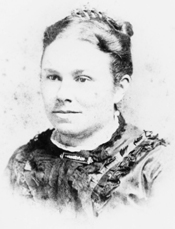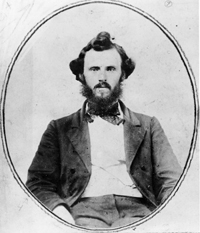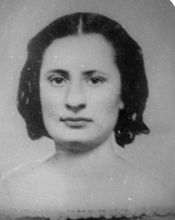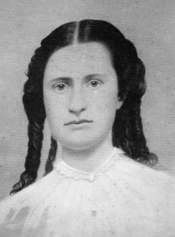|
With a step outside her warm house that morning, a bristling chill laced inside the collar of her traveling coat. Down the
steps to the barren street, the gaslights just going out, she smoothed her skirts from another bluster and looked back at
the house. Would she ever again see that rigid luxury, that box of memories in the once-flourishing mill city of Lowell, Massachusetts?
Would she ever want to?
After tears and kisses on the train platform, she boarded with her luggage and set off for New York where the steamer
would be waiting for her and the others. They were the Mercer Girls, young ladies of high society on a journey to the muddy
avenues of young, rough Seattle, where they would become wives of important men in the history of the region.
And that's the way history remembered them - the Mercer Girls, a "Cargo of Brides" brought by Asa Mercer to
an upstart town with just a few hundred men and nearly no marriageable women. Never mind that one of the girls became the
first public schoolteacher in Seattle, or another the owner of the only hotel that didn't burn in the Great Seattle Fire.
It didn't seem to matter, not to any of the historians, that two of the girls became the first female lighthouse keeper's
assistants in Washington, or that one died just six months after her arrival, or that another was an artist.
No one cared - at least not until another woman, who had a similar past and some training in genealogy, first heard their
story.
A fraction of the story

|
| Sarah Cheney |
Since the whole affair started, newspapers and textbooks have referred to the ladies as the Mercer Girls, and sometimes as
the Mercer Maids. They tell an abbreviated story of 11 young women who arrived in Seattle late on May 15, 1864, with their
escort Asa Mercer. Acting with the support of many men in Seattle and city officials, he had traveled to Lowell, Mass., earlier
that year to recruit women to travel back west with him and marry the men there, who had been complaining of their ratio to
available women: nine to one. Mercer found his ladies, and they set out with him on March 14, 1864, on the voyage south to
Panama, then north to San Francisco and finally Seattle.
According to most historical accounts, the story ends there. The women either took jobs or married and settled, and the
subsequent chapters of Seattle history swallowed them - until an unlikely researcher wanted to know more.
"The history books never talked about the individual girls, who they were, or what happened to them," said Peri
Muhich, of Renton, while sitting at her desk upstairs at Historic Seattle, an architectural preservation organization where
she works. Files, folders and old encyclopedias surrounded her. "What were their names, why did they come - and what
did they leave behind," she wondered.
For the past 11 years, those questions and more compelled Peri to dig deeper into public records, newspapers and dusty
attics than any historian had before on the subject, and what she found was much more than the few basic facts about each
of the Mercer Girls she originally hoped to. She found information that revealed the women as individuals with hopes and dreams,
who did much more than marry once they arrived.
"They all became really involved in the history of the Northwest, in addition to marrying, most of them, and raising
a family," said Peri. "They had to be adventurous to come. For Asa Mercer to convince them to come here, and then
for them to stay, they had to be amazing people. They really haven't been given the credit they deserve."
Recently, Peri has been working to change that. She visits different groups and organizations whenever she can, presenting
her research in a multimedia lecture, and started a Web site, www.mercergirls.com, that's the most complete and accurate account
of the story today. On March 18 this year, the Seattle Times featured her work and her search for some long lost photos of
the girls. Since then she and the writer of the feature, Sherry Stripling, have discussed a partnership to preserve the Mercer
Girls' full stories in a book.
A book wasn't in the plan originally, said Peri, but neither was over a decade of research on people she's not related
to, either. "I didn't think [the research] would take very long. Now, 11 years later," she said laughing, "I'm
still not completely finished."
It may take a lifetime of research before she's finished, and still she may never find out who each of these women really
were, but it would be a lifetime of essential research, says the Museum of History and Industry's Public Historian, Lorraine
McConaghy, Ph.D.
"It's important to larger areas of scholarship," she said, "women's studies, politics, family histories
- Peri's chosen such an important topic, and she perceives the women individually, not as a chorus line of 'seven brides for
seven brothers.' That's the great gift she brings to this research, and that's what's new - seeing them as people," said
McConaghy.
It was McConaghy, a part-time instructor at the University of Washington (in addition to her job at MOHAI), who first
introduced Peri to the Mercer Girls in a genealogy class. Peri later looked for more information in the library but was unable
to find anything more. But already captivated, she set out to find it on her own.

|
| Asa Mercer |

|
| Georgianna Pearson |
A human connection
Unless driven by some passion, too, it's hard to believe Peri persevered through the years, working around the brick walls
that sometimes stood in her way and celebrating small victories when they collapsed. At one point, the research threatened
to come between her and her husband, who thought she was spending too much time on it and asked her to stop. That's all over
now, says Peri, adding that it was most difficult to stay committed to the research when others didn't take her seriously.
Those are the times when passion drives her - passion and a similar life experience she shares with the Mercer Girls.
Peri was born in Texas, and moved to Fairbanks, Alaska with her family when she was 13. She lived there until a divorce
and too many bad memories prompted her to leave. So to Seattle she came, in 1987, where she met her current husband.
"When I left Alaska, I came by myself, to go to school. I felt I came to Seattle to start something new. I came alone,
like they did, and I met my husband. It was a new adventure. That's one of the reasons I was drawn to the Mercer Girls - they
must have had the same sense of adventure. I feel I have a connection with them," said Peri.
Also a single woman in a new town, Peri experienced some of what must have made life difficult for the Mercer Girls. She
wanted to buy a car, but the dealer told her she should bring in her husband. Then they could talk.
"That's where it started becoming personal with me," said Peri. "I get very emotional because I want people
to know about these girls. Since the very first, they have always been the Mercer Girls - the Asa Mercer Girls. I want to
share as much as I can about them."
The girls have become such a part of her life over the years that Peri also says they feel like her own children. "I
don't have any children, so in a way the girls are becoming my legacy - something for me to leave behind."
They've also left their own legacies behind in stories and people, a handful of which Peri has managed to find. In 1998,
she hosted a reception for the descendants of the Mercer Girls. Twenty-five people came, including Ivan Fisk, 75, a retired
lawyer from Mercer Island and descendant of Georgianna Pearson. Although he had heard about the Mercer Girls, and had some
idea that he was related to one somehow, Fisk says he never knew what that meant until Peri called him one day.
"I remember her first call. She said 'I found you,' with kind of an explosion. It was then that my history began
to unfold. It's added a whole new dimension to my roots," and to his idea of family, he said. He now feels a kinship
with the other girls' descendants, and even with Peri.
Through such connections, Peri has "family" all over the U.S., from Boston to home, and she's eager to find
more. Of the 11 Mercer Girls, she's found descendants of six plus those of Asa Mercer, helping lead her to photos of seven
- only six of which she has permission to use. The seventh is part of the Seattle Times photo archive, and Peri can't use
it unless she obtains permission from a relative of the girl.
A long wait wouldn't be anything new for her, however. Part of the reason it's taken her 11 years already is that she
researches on her own time. Full-time research is the goal, but Peri says working on her own time hasn't felt like a burden
yet.
"It feels more like an honor," she said. "There are times I feel I have the spirits of these women surrounding
me and pushing me on. I feel like I've been chosen to do this."
If you have any information that may be relevant to Peri's research, or if you would like to invite her to present to
your group, contact her by e-mail at mercergirls@hotmail.com or by phone at (425) 260-3795. Visit her Web site at www.mercergirls.com.

|
| Josie Pearson |
The Mercer Girls, individually
The Mercer Girls were seldom mentioned by name in the history books. Following are the names of all 11 who arrived in Seattle
with Asa Mercer, and their ages when they arrived:
* Antoinette Josephine Baker, age 25
* Elizabeth (Lizzie) Ordway, age 35
* Aurelia Coffin, age 20
* Georgianna (Georgia) Pearson, age 15
* Josephine (Josie) Pearson, age 19
* Sara Jane Gallagher, age 19
* Catherine Stickney, age 28
* Katherine Stevens, age 21 (accompanied by her father Rudolphus Stevens)
* Annie May Adams, age 16
* Sarah Cheney, age 22
* Ann M. Murphy, age 24
|
